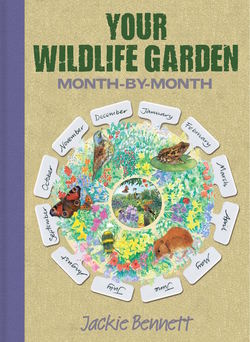Читать книгу Your Wildlife Garden - Jackie Bennett - Страница 45
На сайте Литреса книга снята с продажи.
ОглавлениеMARCH
This is a time of great activity in the garden, as the weather softens and many species of wildlife begin their breeding cycles. In warmer areas frogs will have already laid their spawn, but in others the noisy calls of the males indicate that mating is still under way. Toads usually spawn later than frogs and newts last of all. Toad spawn is easily identifiable as the long double strands of eggs, as opposed to the frogs’ clumps of jelly and the newts’ eggs laid singly on pondweed. There are many threats to the developing young which may prevent them reaching maturity, but perhaps the greatest loss is the large number of adult toads killed each year by cars, as they migrate across roads to their traditional breeding ponds.
Mammals tend to be out of sight this month with fox and badger cubs being born underground. Birds are also busy building nests and defending their territories against intruders. Nesting material is drawn from a wide variety of garden sources, including grass stems, strips of bark, dead leaves and moss taken from the lawn. A slightly unkempt garden or one with a good compost heap is a richer source of nesting material than one which is clinically neat and tidy.
The onset of spring is signalled by a flush of yellow flowers. The vivid yellows of celandines, narcissus and primula seem to act as a beacon to insects emerging from hibernation to seek pollen. The true wild daffodil (Narcissus pseudonarcissus) is generally later to emerge than the garden species and may not appear until next month. It is smaller and less ostentatious than its hybridised cousins and perfectly suited to the wildlife garden.
tasks
FOR THE
month
INTRODUCING FROGS AND TOADS
If the garden pond has no amphibians, it is possible to ‘import’ frog, toad or newt spawn from other ponds. This is the only way to increase the population as it is inadvisable to move tadpoles and quite cruel to move adults from their home pond. Take a bucketful of water, pond weed and spawn from a neighbouring pond. It is best to take more than you need as some batches of spawn will not survive the change of water temperature.
CHECKLIST
Reduce bird feeding
Borders: weed and mulch
Lift and divide water plants
Clip heathers and lavender
Sow half-hardy annuals under glass
BIRD FEEDING
Unless the weather is particularly harsh, reduce feeding as nesting begins. Hard bread and peanuts are harmful to newly hatched birds, so restrict food supplies to soft fat or grated cheese. Reducing the amount of food supplied will encourage the adults to start feeding on the emerging insects. However, if the ground is frozen, keep up the feeding until the bad weather passes.
DEALING WITH WEEDS
Perennial flower and shrub borders should be checked now for weeds and unwanted seedlings. Perennial weeds like ground elder will need to be dug out thoroughly as even the tiniest section of root left in the soil can sprout again. Annual weeds can be dealt with more easily, by disturbing only the top layer of soil. Use a garden fork (or hand fork) to lift them out of the soil, pulling the plant and stem cleanly away.
MULCHING
To suppress further weeds from growing, cover the soil with a layer of mulch. This can be any material that excludes light from the soil, thus preventing weeds from growing. Black polythene or old carpet will suppress weeds and conserve the moisture already in the ground, although neither looks particularly attractive. A 5–8cm (2–3in) layer of chopped bark gives a natural woodland floor finish and birds do not seem to mind scattering the pieces to find insects. Another alternative is garden compost, which has the added bonus of releasing its nutrients into the soil throughout the spring and summer. These mulches will prevent the need to use chemical weedkillers and cut down on watering later in the summer.
DIVIDING MARGINAL POND AND WETLAND PLANTS
In established ponds, marginal species can outgrow their space in the shallow water around the edge and need to be renewed by division. Spring is the best time to do this, just as the plants are starting their growth.
Dividing clump-forming plants
This method applies to marsh marigold (Caltha palustris) and most other moisture-loving perennials.
Marginal plants that grow in clumps or mounds can be broken up simply with a hand fork. Lift the plant out of the soil or water and, using the fork, prise away small clumps from the outside of the main clump. Choose young, healthy-looking parts of the plant and discard the interior which may have become exhausted.
Replant the new pieces immediately, into other parts of the pond. If not needed immediately, they can be grown on in pots of wet compost.
Dividing creeping plants
This method applies to flowering rush (Butomus umbellatus), bog bean (Menyanthes trifoliata), bog arum (Calla palustris), water mint (Mentha aquatica) and lesser celandine (Ranunculus ficaria). The roots of these plants have a scrambling habit and can be increased by dividing the horizontal rootstock into sections.
